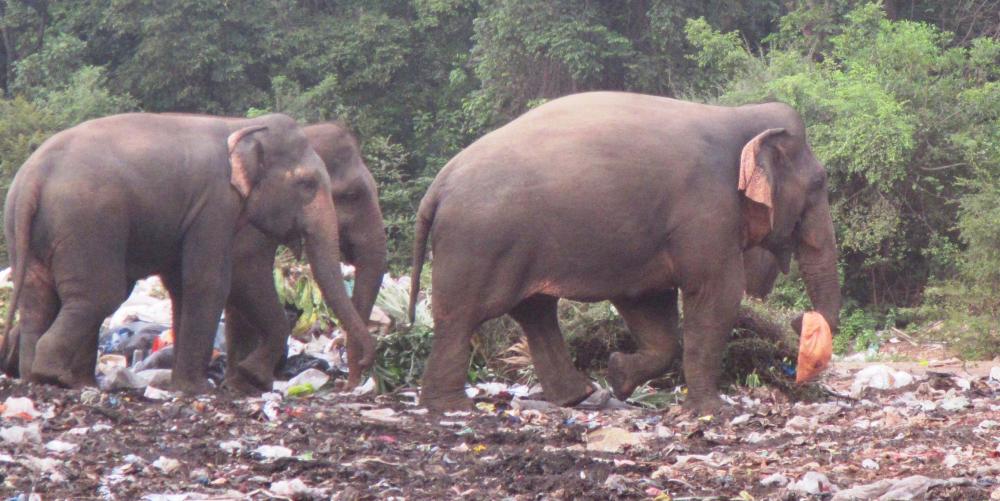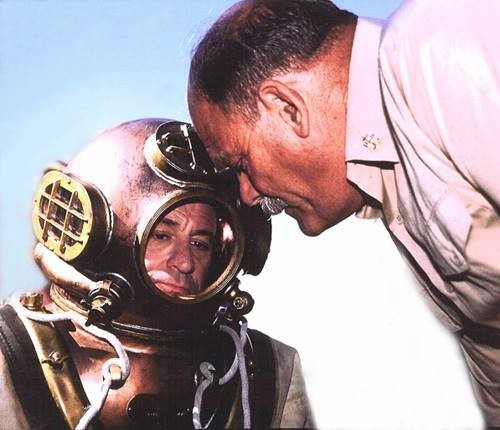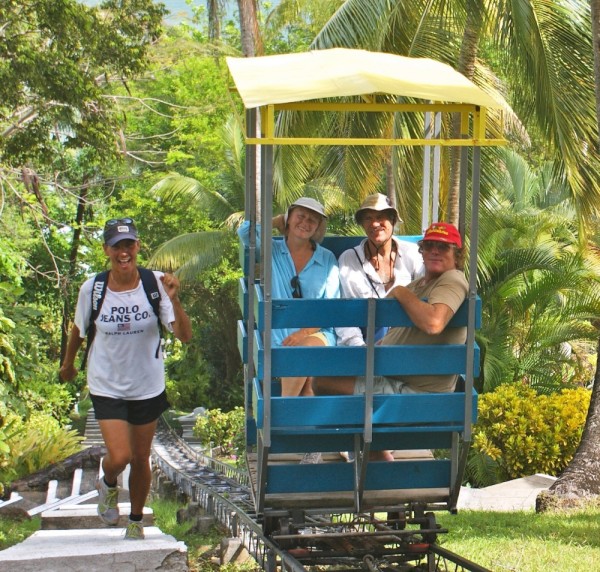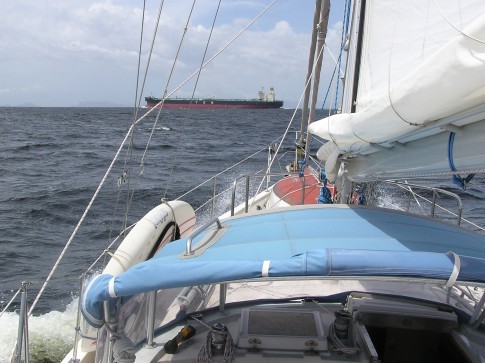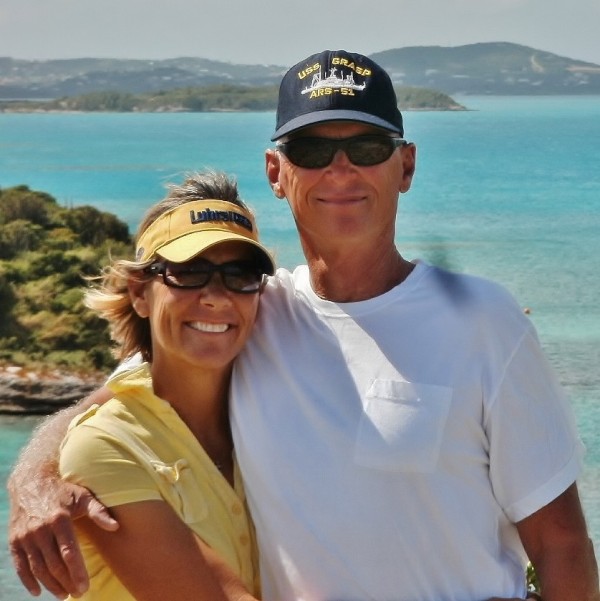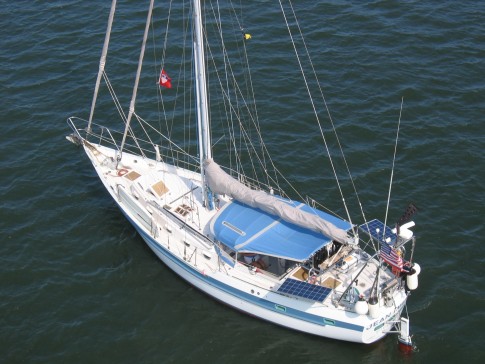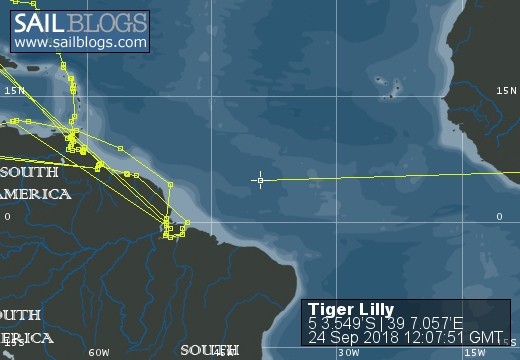
S/V Tiger Lilly
Rig heavy, reef early, and pray often; for God does not assure us an easy passage, but He does promise a safe anchorage...
25 May 2018 | TRINCOMALEE, SRI LANKA
02 January 2018 | Clan Jeti Anchorage, Georgetown, Penang Island, Malaysia
03 November 2016 | Singapore, Southeast Asia
02 October 2016 | Kumai River, Borneo
24 August 2016 | Rindja Island, Indonesia
22 July 2016 | Fannie Bay, Darwin, Northern Territory, Australia
14 June 2016 | Pancake Creek, Queensland, Australia
13 June 2016 | Pancake Creek, Queensland, Australia
11 June 2016 | Burnette Heads, Queensland, Australia
07 June 2016 | Mooloolaba, Queensland, Australia
11 May 2016 | Colmsie, Brisbane River, Queensland, Australia
23 December 2015 | Brisbane, Australia
13 August 2015 | Whangarei, New Zealand
07 August 2015 | Whangarei, New Zealand
23 July 2015 | Whangarei, New Zealand
12 April 2015 | Whangarei, New Zealand
11 February 2015 | Whangarei, New Zealand
25 January 2015 | Whangarei, New Zealand
24 September 2014 | BORA BORA, French Polynesia
23 September 2014 | Bora Bora
TIGER LILLY - DISASTER ON THE WAY TO PARADISE
26 September 2011 | St. Augustine Marine Center
Capt. Tom Service
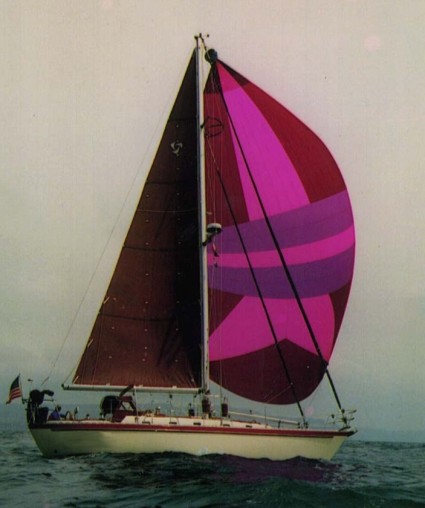
In 1999 Tom was the Ombudsman for a marine insurance company, and at their request he wrote this article for "SOUTHWINDS" sailing magazine. The original logs from the Coast Guard's Atlantic Operations Center, interviews with S/V Kampeska's owners, and input from the air crew who flew this challenging mission were used to develop this actual story of courage, heartbreak, and the raw power of the sea. This is the real deal. As the end of the 2011 hurricane season approaches, and we begin to plan our passages south to the tropics, perhaps now would be a good time to review (or develop) our individual heavy weather management plans. I hope this helps.
Warm regards,
Tom & Lilly Service
S/V Tiger Lilly
In early November 1998 Roy and Karen Olson were under way aboard their Tayana 42 cutter S/V Kampeska with 68 other boats in the West Marine Caribbean 1500 Rally. They departed from Norfolk with 52 other boats, while 16 boats had sailed from Newport. Their destination was Virgin Gorda in the balmy British Virgin Islands. Roy's brother, Roger, and his wife, Judee, were sailing as crew. Typical of mom & pop cruising couples, Roy and Karen had worked hard together and spent a lot of money putting their dream of a liveaboard cruising sailboat together. They named their beloved cruising home after Lake Kampeska, a peaceful body of water back home in South Dakota where they learned to love the water. They had equipped Kampeska for the dual roles of safe offshore passage making, and providing a comfortable retirement home for a husband and wife. The Olsons had more sailing and cruising experience than the majority of their Rally-mates heading South. They had over 10,000 miles of bluewater sailing behind them, and 13 months living aboard another vessel in the Caribbean. They had easily met all of the safety equipment requirements listed in an extensive Rally checklist. After a prolonged period ashore preparing their boat, these eager and energetic sailors had completed their preparations and were setting out to explore the West Indies. All hands aboard Kampeska were looking forward to cruising the sunny Caribbean, but first they had to get there.
When S/V Kampeska left Norfolk heading southeast on 1 November 1998 they had a clear weather report and light conditions. On that same Sunday afternoon, Tropical Depression Mitch, the remnants of the strongest October hurricane ever recorded, was dissipating and producing torrential rains over the jungles of the Guatemala - Mexico border. Neither the crew of the Kampeska, nor the staff of the Caribbean 1500, who provided the Rally with twice daily weather reports, had any idea that they were heading for a rendezvous with the tail end of a Central American hurricane. The first two days out of Chesapeake Bay the crew enjoyed a full range of conditions and pleasant sailing, but by the third day underway the wind had built to a formidable 30 knots out of the southwest. Meanwhile, Tropical Depression Mitch wandered into the Bay of Campeche some 1600 miles south-southwest of S/V Kampeska and found new life in the bay's warm waters. With a developed low level circulation building the system back to Tropical Storm force, Mitch began to move across the Yucatan Peninsula toward the east with a renewed determination. Wednesday 4 November found Kampeska pounding to weather in gale force winds from the southwest. That morning, Roy Olson received a weather report from the Rally weather forecasters ashore that a deep low-pressure system to the north was bearing down on the Caribbean 1500 Fleet. Many of the boats headed for Bermuda to seek safe haven. However, the decision was made that Kampeska would press south at best speed in an effort to stay below the low. Mid-morning on that same day, Mitch, attenuated by the effects of land and again reduced to Tropical Depression force, cleared the Yucatan and began a march to the northeast across the warm waters of the southern Gulf of Mexico. As it headed for South Florida, Mitch became involved with a frontal zone moving through the Eastern Gulf of Mexico. Within hours Mitch was back up to tropical storm strength, and very much back into the picture. Kampeska and her crew were only 36 hours away from being caught in a deadly pincer between two very powerful and distinct weather systems. On Thursday 5 November Kampeska was laboring in 40 knots of wind that had backed into the south and was strengthening each hour. Progress early in the day was difficult, and by the afternoon she was unable to make any headway in the storm force winds. By nightfall they were about 200 miles southwest of Bermuda; the wind was howling a steady 50 knots from the south, with gusts to 60 and 70 knots. At 2000 the decision was made to ride out the storm lying ahull - the sails were furled, the wheel was lashed, and the crew went below. As the deep North Atlantic low-pressure system overtook them, Kampeska and her crew were at the mercy of a violent sea. On the morning of 5 November Mitch slammed into Naples with 60 knot winds, punched its way across the South Florida Peninsula, and barreled out across the Straights of Florida like a freight train - fueled by the warmth of the Gulf Stream. By that afternoon Mitch cleared the northern Bahamas tracking to the northeast - with a speed of advance of approximately 50 knots - where the cool waters of the North Atlantic transformed Mitch into a powerful extra-tropical low-pressure system. It was a difficult night aboard Kampeska. With no sail to steady her as the storm force winds battered on her beam, she was tossed violently about in the trough of heavily breaking seas. The fury of the two approaching weather systems played havoc with the sea, heaping its surface into steep and confused waves, and putting Kampeska in the grip of storm force winds. It was a dirty night, and the graybeards of the North Atlantic were out. Thankfully, toward daylight on the morning of 6 November conditions began to moderate, and the sea did not seem so violent. As sailors have done since man first started going down to the sea, the crew found hope as they anticipated sunrise - perhaps the worst was over. At about 0500 the small secure world below deck on Kampeska was shattered when she was boarded by a "rouge" wave on the beam. Kampeska was rolled, capsized, and dismasted. Disaster had struck on the way to paradise, and 4 souls found themselves in a battle for survival on a very big and dangerous ocean.
When S/V Kampeska righted herself, the deck was cleared of all structure and equipment; the life raft was gone, and the previously deck-stepped mast hung over the side - suspended under the boat by its rigging. Each time the boat rolled in the beam-on 20 foot seas, the mast battered the hull. Roy was flat on the cabin sole with a broken back, and his brother, Roger, had taken such a severe blow to the head that he didn't know where he was. Both men were out of commission. Karen had broken ribs, and Judee had been battered and bruised as everyone and everything in the interior of the boat was tumbled and smashed as the vessel capsized. The unsecured floorboards were adrift, opening the bilge to the food, dishes, and books that were sliding around on the cabin sole. Major gear and equipment stayed in place, but some of the drawers and lockers had opened under the impact of the wave. It is hard to imagine a more traumatic event than turning over a small boat, full of people, in a violent sea. Thankfully, Kampeska maintained her structural and watertight integrity, taking only a nominal amount of water in the bilge. However, the gear adrift in the bilges clogged the pump strainers. These folks are from hearty South Dakota stock, and Karen and Judee, under the direction of Roy on his back on the cabin sole, set about the task of sorting this mess out. But first they activated their 406 MHz Emergency Position Indicating Radio Beacon (EPIRB) to summon assistance.
Kampeska's EPIRB signal was detected by the SARSAT 7 search and rescue satellite orbiting high above the North Atlantic, and down-linked to the French Maritime Control Center at Toulouse. The data was processed, Kampeska's position determined, and the information was relayed to the US Mission Control Center (USMCC) at Suitland, MD. It was early on the morning of 6 November when the USMCC duty officer notified the USCG Atlantic Area staff in Portsmouth, VA that Kampeska's mariners were in distress. As a determined crew aboard Kampeska fought to save their vessel, an equally determined professional search and rescue team ashore sprang into action. Thus began a combined rescue operation that would involve hundreds of sailors, airmen, and support staff all along the US Eastern Seaboard, working together in foul weather and dangerous conditions to bring these 4 souls home safely. The following events were immediately initiated: two USCG C-130 Hercules long range search aircraft and one HH-60J Jayhawk rescue helo were dispatched from the USCG Air Station at Elizabeth City, NC; USN E-2 air early warning aircraft was launched from the Norfolk Naval Air Station to assist the USCG air search; the 21,000 ton bulk carrier M/V Northern Progress was diverted from her voyage to Jamaica and sent to the SARSAT position; the USS Enterprise Battle Group diverted a destroyer to provide at-sea refueling (a "Lilypad") for the USCG rescue helo; USAF para-rescue jumpers were put on standby at Moody Air Force Base in Georgia; and a sea-going tug and doctor were put on standby in Bermuda. About 5 hours after Kampeska's crew declared an emergency by turning their EPIRB on, the first USCG C-130 search aircraft had found them, dropped a radio and medical supplies, and was talking to the crew. By early afternoon the M/V Northern Progress had arrived at Kampeska's location. With the wind blowing 28 knots and seas still at 15 to 20 feet, conditions at the scene made it very difficult to maneuver a 21,000 ton single-screw merchant ship, sailing in-ballast, alongside the drifting hulk of a 42 foot sailboat. Two unsuccessful attempts were made to put a line over to Kampeska. The Captain of M/V Northern Progress reported to the USCG that the situation was serious. The seas were too rough to continue any further attempts to transfer personnel, and it was apparent to him that Kampeska's crew was "distraught and exhausted." Kampeska's crew needed to be removed from the hulk as soon as possible. Two other sailing yachts in the area, S/V Elixir and S/V Alexia (with a disabled engine) had heard the rescuers talking to Kampeska on the VHF radio, and they sailed to the scene to stand by her. The Captain of M/V Northern Progress positioned his ship upwind of Kampeska to provide them a lee from the wind and heavy seas that were still running. As darkness fell over the North Atlantic, M/V Northern Progress illuminated the hulk of Kampeska with her powerful searchlight. With a surface personnel transfer not possible, the USCG Air Station at Elizabeth City launched an HH-60 rescue helo and the second C-130 escort for the long night flight to Bermuda. This was not an every-day operation for the HH-60 helo crew. Positioning the HH-60 in Bermuda dictated an at-sea night refueling on the pitching deck of a Navy destroyer; a very challenging operation that required the highest level of airmanship. After the 4 ½ hour flight, both aircraft were staged at Bermuda for a first-light rescue attempt early the next morning. The merchant seamen aboard M/V Northern Progress illuminated the disabled sailboat throughout the night. They could only offer prayers of hope for the 4 souls aboard Kampeska's hulk, as they watched Kampeska pounded by the still-angry sea. Clearly, their fate was in God's hands that dark night.
Although the day began with the passive and irreversible act of energizing their EPIRB, Kampeska's crew bravely worked together with determination and purpose to preserve their tenuous situation until help arrived. The first order of business was to clear the bilge. Considering the blow that Kampeska had been dealt, there was surprisingly little water inside the boat. Although Roy kept a good clean bilge, the unsecured floorboards allowed books, food, and the contents of the galley sink to enter the bilge and foul the pumps. Karen and Judee, both painfully injured, worked systematically in the lurching cabin to repeatedly clear the bilge pump strainers. Although the engine would start and run, the electrical system had been damaged during the capsize, and the alternator would not charge the batteries. With the remnants of the rigging hanging over the side, using the rudder and engine to head her up into the wind and seas would immediately foul the propeller. Roy had kept the batteries charged up during the storm, so they had adequate power to run the pumps and dewater the boat - if they were not holed. Once cleared, the pumps were able to keep up with the minimal ingress of seawater. Apparently the hull was still sound. The rechargeable battery for the handheld VHF radio was low, but the 110 VAC inverter was out of commission and could not be used to charge it. When the first Coast Guard C-130 appeared overhead, Kampeska used the radio to receive their instructions, but were very limited on power to transmit. They had all the necessary tools aboard to clear the wreckage of the mast and rigging; however, with no way to steady the boat as she lay in the trough across the heavy seas, her motion was so violent that neither of the women could go forward on the wrecked deck to work without danger of going over the side. Kampeska's hull would just have to withstand the beating from the mast until they were rescued. There was no other option. Kampeska's violent motion made it very difficult to recover the radios that the C-130 dropped to them, but on the second try they were successful and established two-way communications with their rescuers. Likewise, when the M/V Northern Progress saw their flares and approached the wreck, the rough seas and Kampeska's excessive motion made working on deck and recovering the messenger line an impossible task. The heavy seas made it extremely dangerous for Kampeska to get too close to the high steel sides of M/V Northern Progress. Without a life raft, they were grateful that M/V Northern Progress, S/V Elixir, and S/V Alexia were standing by them. They had been informed by Northern Progress' Captain of the Coast Guard's plan to take them off by helo early the next morning, but first they had to get through another night on the stormy North Atlantic. With a tenacious faith and discipline that few individuals could muster in such a dangerous and uncomfortable situation, Karen maintained the morale and strength of the crew by feeding them. Their last meal aboard Kampeska consisted of cereal, fruit, crackers, and orange juice. Those 4 souls spent that long night bathed in M/V Northern Progress' search light, wearing large offshore-style life jackets, and praying that Kampeska's hull could withstand the constant battering from her mast.
Just prior to dawn on the morning of 7 November the second C-130 called Kampeska on the radio; they and the HH-60 rescue helo were inbound to their position. The crew prepared to leave Kampeska for the last time. By now they had spent 26 difficult hours in a drifting 42 foot hulk on a tumultuous sea. In spite of the women's best efforts, the crew was worn out both mentally and physically. Kampeska's location southwest of Bermuda required that the HH-60 helo crew fly a 440 mile round trip, with only 60 minutes of fuel available for time on-station to complete the rescue of 4 people from the deck of a small boat in 30 knots of wind and 15 to 20 foot seas. Although this helo crew was only the spear-head of an enormous search and rescue organization, the young Coast Guard men and women who fly these difficult and dangerous missions are truly modern day heroes. With the C-130 overhead flying cover and providing a communications link ashore, the HH-60 approached Kampeska and splashed a Coast Guard rescue swimmer. The rescue swimmer boarded Kampeska and began briefing her crew for evacuation. Roger, Judee, and Karen were individually hoisted from the cabin top to the helo in the rescue-transfer basket. Getting Roy, with a broken back, off the heaving deck of Kampeska without further injury required the finest technique by the rescue swimmer in the most arduous of circumstances. Roy nearly passed out from the pain of moving from the cabin sole to the cockpit, but there was no alternative. The rescue basket was lowered into the violently rolling cockpit, and Roy was snatched off Kampeska for the final time. The rescue swimmer was hoisted back aboard the helo; it had taken over 40 minutes on station to complete the rescue. S/V Kampeska, once the trim and secure sea-going home of Roy and Karen Olson, was now an abandoned derelict - adrift and at the mercy of the mighty North Atlantic. The 1 ½ hour flight back to Bermuda was a difficult time for Kampeska's crew. Although they were now safe from the rigors of the sea, and the dangerous situation aboard Kampeska, Roy's condition was cause for serious concern.
Ambulances were waiting on the tarmac for the Coast Guard Jayhawk helo as it touched down in Bermuda. With less than 10% of their fuel left, and a maximum load of passengers aboard, the helo's crew had completed this challenging rescue at the outer limit of their aircraft's operational envelope. Kampeska's crew was immediately transported to the hospital in Hamilton, where the doctors advised that Roy had to be evacuated to the US mainland for extensive medical treatment as soon as possible. Karen notified the folks at the Blue Water Lifeline - Worldwide Assistance Services that Roy needed to be evacuated to the United States as soon as possible: a call she never wanted to make, but was so thankful that she was able to. A Lear jet air ambulance with a medical evacuation team aboard was dispatched to Bermuda. Roy and Karen were flown to Baltimore, where Roy was admitted to Johns Hopkins Medical Center for treatment. Roger and Judee were treated for their injuries in Bermuda, and returned home to South Dakota on commercial air. All four survivors are now back home convalescing. Roy is up and about, his broken back on the mend. Roger has fully recovered from his concussion and is back to work. Karen's broken ribs are healed, as are Judee's cuts and bruises. Kampeska was last reported seen a week after the incident by the 20,000 ton Indonesian bulk carrier M/V Pooja, about 65 miles southeast of where she was abandoned. She was given up to the vicissitudes of the sea and declared lost: Roy and Karen's shattered dream, to live aboard Kampeska and sail the grand oceans of the world, was also gone...
LESSONS LEARNED:
As a former Commanding Officer of a US Navy salvage & rescue ship I have participated in several high seas rescue and towing operations. During my 1987-1991 circumnavigation aboard my CSY44 I was caught in an Indian Ocean cyclone a full 2 months before Tropical Storm Season. I can tell you from first-hand experience that the Olsons were indeed very lucky. Usually events like this are simply reported as "vessel has gone missing in heavy weather and presumed lost with all hands." As cruising sailors, I suggest that we all take a few moments and think about the Olson's experience aboard Kampeska - caught between two powerful storm systems in the North Atlantic. What should have been a routine passage, which typically includes some heavy weather, turned into a major search and rescue operation. Hundreds of people, and an awful lot of the taxpayer's money, were expended on behalf of 4 cruisers adrift on their damaged sailboat. Other cruising sailboats were exposed to similar conditions during that same storm and survived intact. Each year we read accounts of yachts caught in heavy weather and damaged or lost. Yet, it is not at all unusual that nearby vessels of a similar size were exposed to the same conditions, with a far different - and more successful - outcome. Why? I believe that only part of the answer is luck. Rouge waves do form and cause havoc in their path, but mostly the differences can be explained by the actions of the individual crews.
A vessel laying a-hull and beam-to in breaking seas is in grave danger of being knocked down and capsized. The weather systems that produce such conditions are not rare, and can be experienced on almost any ocean passage - even those conducted during the "right season." If we intend to sail offshore this coming sailing season, prudence dictates we review our own situations: our boats, our gear, our personal training and experience, and have a realistic storm management plan - which we have actually drilled. I found Heavy Weather Sailing by Coles and Bruce, and The Storm Tactics Handbook by Lin & Larry Pardee to be excellent guides on this subject. I believe that both books, based on the actual experience of riding out many storms at sea by the expert seamen who wrote them, make an air-tight case for using storm trysails with sea anchors, and storm jibs with drouges to safely and comfortably deal with conditions like those which capsized S/V Kampeska. Sailors have been using the "safety valve" of heaving to in heavy weather for hundreds of years. Are you and your vessel prepared to effectively heave to? Have you actually drilled your proposed plan in even moderate (25-30 knot) conditions? Think about it... before you sail offshore.
To view the photos and a graphic that go with this posting please navigate to our PHOTO GALLERY (upper right corner of this page) thusly: TIGER LILLY'S BEST / THE LOSS OF KAMPESKA.
Warm regards,
Tom & Lilly Service
S/V Tiger Lilly
In early November 1998 Roy and Karen Olson were under way aboard their Tayana 42 cutter S/V Kampeska with 68 other boats in the West Marine Caribbean 1500 Rally. They departed from Norfolk with 52 other boats, while 16 boats had sailed from Newport. Their destination was Virgin Gorda in the balmy British Virgin Islands. Roy's brother, Roger, and his wife, Judee, were sailing as crew. Typical of mom & pop cruising couples, Roy and Karen had worked hard together and spent a lot of money putting their dream of a liveaboard cruising sailboat together. They named their beloved cruising home after Lake Kampeska, a peaceful body of water back home in South Dakota where they learned to love the water. They had equipped Kampeska for the dual roles of safe offshore passage making, and providing a comfortable retirement home for a husband and wife. The Olsons had more sailing and cruising experience than the majority of their Rally-mates heading South. They had over 10,000 miles of bluewater sailing behind them, and 13 months living aboard another vessel in the Caribbean. They had easily met all of the safety equipment requirements listed in an extensive Rally checklist. After a prolonged period ashore preparing their boat, these eager and energetic sailors had completed their preparations and were setting out to explore the West Indies. All hands aboard Kampeska were looking forward to cruising the sunny Caribbean, but first they had to get there.
When S/V Kampeska left Norfolk heading southeast on 1 November 1998 they had a clear weather report and light conditions. On that same Sunday afternoon, Tropical Depression Mitch, the remnants of the strongest October hurricane ever recorded, was dissipating and producing torrential rains over the jungles of the Guatemala - Mexico border. Neither the crew of the Kampeska, nor the staff of the Caribbean 1500, who provided the Rally with twice daily weather reports, had any idea that they were heading for a rendezvous with the tail end of a Central American hurricane. The first two days out of Chesapeake Bay the crew enjoyed a full range of conditions and pleasant sailing, but by the third day underway the wind had built to a formidable 30 knots out of the southwest. Meanwhile, Tropical Depression Mitch wandered into the Bay of Campeche some 1600 miles south-southwest of S/V Kampeska and found new life in the bay's warm waters. With a developed low level circulation building the system back to Tropical Storm force, Mitch began to move across the Yucatan Peninsula toward the east with a renewed determination. Wednesday 4 November found Kampeska pounding to weather in gale force winds from the southwest. That morning, Roy Olson received a weather report from the Rally weather forecasters ashore that a deep low-pressure system to the north was bearing down on the Caribbean 1500 Fleet. Many of the boats headed for Bermuda to seek safe haven. However, the decision was made that Kampeska would press south at best speed in an effort to stay below the low. Mid-morning on that same day, Mitch, attenuated by the effects of land and again reduced to Tropical Depression force, cleared the Yucatan and began a march to the northeast across the warm waters of the southern Gulf of Mexico. As it headed for South Florida, Mitch became involved with a frontal zone moving through the Eastern Gulf of Mexico. Within hours Mitch was back up to tropical storm strength, and very much back into the picture. Kampeska and her crew were only 36 hours away from being caught in a deadly pincer between two very powerful and distinct weather systems. On Thursday 5 November Kampeska was laboring in 40 knots of wind that had backed into the south and was strengthening each hour. Progress early in the day was difficult, and by the afternoon she was unable to make any headway in the storm force winds. By nightfall they were about 200 miles southwest of Bermuda; the wind was howling a steady 50 knots from the south, with gusts to 60 and 70 knots. At 2000 the decision was made to ride out the storm lying ahull - the sails were furled, the wheel was lashed, and the crew went below. As the deep North Atlantic low-pressure system overtook them, Kampeska and her crew were at the mercy of a violent sea. On the morning of 5 November Mitch slammed into Naples with 60 knot winds, punched its way across the South Florida Peninsula, and barreled out across the Straights of Florida like a freight train - fueled by the warmth of the Gulf Stream. By that afternoon Mitch cleared the northern Bahamas tracking to the northeast - with a speed of advance of approximately 50 knots - where the cool waters of the North Atlantic transformed Mitch into a powerful extra-tropical low-pressure system. It was a difficult night aboard Kampeska. With no sail to steady her as the storm force winds battered on her beam, she was tossed violently about in the trough of heavily breaking seas. The fury of the two approaching weather systems played havoc with the sea, heaping its surface into steep and confused waves, and putting Kampeska in the grip of storm force winds. It was a dirty night, and the graybeards of the North Atlantic were out. Thankfully, toward daylight on the morning of 6 November conditions began to moderate, and the sea did not seem so violent. As sailors have done since man first started going down to the sea, the crew found hope as they anticipated sunrise - perhaps the worst was over. At about 0500 the small secure world below deck on Kampeska was shattered when she was boarded by a "rouge" wave on the beam. Kampeska was rolled, capsized, and dismasted. Disaster had struck on the way to paradise, and 4 souls found themselves in a battle for survival on a very big and dangerous ocean.
When S/V Kampeska righted herself, the deck was cleared of all structure and equipment; the life raft was gone, and the previously deck-stepped mast hung over the side - suspended under the boat by its rigging. Each time the boat rolled in the beam-on 20 foot seas, the mast battered the hull. Roy was flat on the cabin sole with a broken back, and his brother, Roger, had taken such a severe blow to the head that he didn't know where he was. Both men were out of commission. Karen had broken ribs, and Judee had been battered and bruised as everyone and everything in the interior of the boat was tumbled and smashed as the vessel capsized. The unsecured floorboards were adrift, opening the bilge to the food, dishes, and books that were sliding around on the cabin sole. Major gear and equipment stayed in place, but some of the drawers and lockers had opened under the impact of the wave. It is hard to imagine a more traumatic event than turning over a small boat, full of people, in a violent sea. Thankfully, Kampeska maintained her structural and watertight integrity, taking only a nominal amount of water in the bilge. However, the gear adrift in the bilges clogged the pump strainers. These folks are from hearty South Dakota stock, and Karen and Judee, under the direction of Roy on his back on the cabin sole, set about the task of sorting this mess out. But first they activated their 406 MHz Emergency Position Indicating Radio Beacon (EPIRB) to summon assistance.
Kampeska's EPIRB signal was detected by the SARSAT 7 search and rescue satellite orbiting high above the North Atlantic, and down-linked to the French Maritime Control Center at Toulouse. The data was processed, Kampeska's position determined, and the information was relayed to the US Mission Control Center (USMCC) at Suitland, MD. It was early on the morning of 6 November when the USMCC duty officer notified the USCG Atlantic Area staff in Portsmouth, VA that Kampeska's mariners were in distress. As a determined crew aboard Kampeska fought to save their vessel, an equally determined professional search and rescue team ashore sprang into action. Thus began a combined rescue operation that would involve hundreds of sailors, airmen, and support staff all along the US Eastern Seaboard, working together in foul weather and dangerous conditions to bring these 4 souls home safely. The following events were immediately initiated: two USCG C-130 Hercules long range search aircraft and one HH-60J Jayhawk rescue helo were dispatched from the USCG Air Station at Elizabeth City, NC; USN E-2 air early warning aircraft was launched from the Norfolk Naval Air Station to assist the USCG air search; the 21,000 ton bulk carrier M/V Northern Progress was diverted from her voyage to Jamaica and sent to the SARSAT position; the USS Enterprise Battle Group diverted a destroyer to provide at-sea refueling (a "Lilypad") for the USCG rescue helo; USAF para-rescue jumpers were put on standby at Moody Air Force Base in Georgia; and a sea-going tug and doctor were put on standby in Bermuda. About 5 hours after Kampeska's crew declared an emergency by turning their EPIRB on, the first USCG C-130 search aircraft had found them, dropped a radio and medical supplies, and was talking to the crew. By early afternoon the M/V Northern Progress had arrived at Kampeska's location. With the wind blowing 28 knots and seas still at 15 to 20 feet, conditions at the scene made it very difficult to maneuver a 21,000 ton single-screw merchant ship, sailing in-ballast, alongside the drifting hulk of a 42 foot sailboat. Two unsuccessful attempts were made to put a line over to Kampeska. The Captain of M/V Northern Progress reported to the USCG that the situation was serious. The seas were too rough to continue any further attempts to transfer personnel, and it was apparent to him that Kampeska's crew was "distraught and exhausted." Kampeska's crew needed to be removed from the hulk as soon as possible. Two other sailing yachts in the area, S/V Elixir and S/V Alexia (with a disabled engine) had heard the rescuers talking to Kampeska on the VHF radio, and they sailed to the scene to stand by her. The Captain of M/V Northern Progress positioned his ship upwind of Kampeska to provide them a lee from the wind and heavy seas that were still running. As darkness fell over the North Atlantic, M/V Northern Progress illuminated the hulk of Kampeska with her powerful searchlight. With a surface personnel transfer not possible, the USCG Air Station at Elizabeth City launched an HH-60 rescue helo and the second C-130 escort for the long night flight to Bermuda. This was not an every-day operation for the HH-60 helo crew. Positioning the HH-60 in Bermuda dictated an at-sea night refueling on the pitching deck of a Navy destroyer; a very challenging operation that required the highest level of airmanship. After the 4 ½ hour flight, both aircraft were staged at Bermuda for a first-light rescue attempt early the next morning. The merchant seamen aboard M/V Northern Progress illuminated the disabled sailboat throughout the night. They could only offer prayers of hope for the 4 souls aboard Kampeska's hulk, as they watched Kampeska pounded by the still-angry sea. Clearly, their fate was in God's hands that dark night.
Although the day began with the passive and irreversible act of energizing their EPIRB, Kampeska's crew bravely worked together with determination and purpose to preserve their tenuous situation until help arrived. The first order of business was to clear the bilge. Considering the blow that Kampeska had been dealt, there was surprisingly little water inside the boat. Although Roy kept a good clean bilge, the unsecured floorboards allowed books, food, and the contents of the galley sink to enter the bilge and foul the pumps. Karen and Judee, both painfully injured, worked systematically in the lurching cabin to repeatedly clear the bilge pump strainers. Although the engine would start and run, the electrical system had been damaged during the capsize, and the alternator would not charge the batteries. With the remnants of the rigging hanging over the side, using the rudder and engine to head her up into the wind and seas would immediately foul the propeller. Roy had kept the batteries charged up during the storm, so they had adequate power to run the pumps and dewater the boat - if they were not holed. Once cleared, the pumps were able to keep up with the minimal ingress of seawater. Apparently the hull was still sound. The rechargeable battery for the handheld VHF radio was low, but the 110 VAC inverter was out of commission and could not be used to charge it. When the first Coast Guard C-130 appeared overhead, Kampeska used the radio to receive their instructions, but were very limited on power to transmit. They had all the necessary tools aboard to clear the wreckage of the mast and rigging; however, with no way to steady the boat as she lay in the trough across the heavy seas, her motion was so violent that neither of the women could go forward on the wrecked deck to work without danger of going over the side. Kampeska's hull would just have to withstand the beating from the mast until they were rescued. There was no other option. Kampeska's violent motion made it very difficult to recover the radios that the C-130 dropped to them, but on the second try they were successful and established two-way communications with their rescuers. Likewise, when the M/V Northern Progress saw their flares and approached the wreck, the rough seas and Kampeska's excessive motion made working on deck and recovering the messenger line an impossible task. The heavy seas made it extremely dangerous for Kampeska to get too close to the high steel sides of M/V Northern Progress. Without a life raft, they were grateful that M/V Northern Progress, S/V Elixir, and S/V Alexia were standing by them. They had been informed by Northern Progress' Captain of the Coast Guard's plan to take them off by helo early the next morning, but first they had to get through another night on the stormy North Atlantic. With a tenacious faith and discipline that few individuals could muster in such a dangerous and uncomfortable situation, Karen maintained the morale and strength of the crew by feeding them. Their last meal aboard Kampeska consisted of cereal, fruit, crackers, and orange juice. Those 4 souls spent that long night bathed in M/V Northern Progress' search light, wearing large offshore-style life jackets, and praying that Kampeska's hull could withstand the constant battering from her mast.
Just prior to dawn on the morning of 7 November the second C-130 called Kampeska on the radio; they and the HH-60 rescue helo were inbound to their position. The crew prepared to leave Kampeska for the last time. By now they had spent 26 difficult hours in a drifting 42 foot hulk on a tumultuous sea. In spite of the women's best efforts, the crew was worn out both mentally and physically. Kampeska's location southwest of Bermuda required that the HH-60 helo crew fly a 440 mile round trip, with only 60 minutes of fuel available for time on-station to complete the rescue of 4 people from the deck of a small boat in 30 knots of wind and 15 to 20 foot seas. Although this helo crew was only the spear-head of an enormous search and rescue organization, the young Coast Guard men and women who fly these difficult and dangerous missions are truly modern day heroes. With the C-130 overhead flying cover and providing a communications link ashore, the HH-60 approached Kampeska and splashed a Coast Guard rescue swimmer. The rescue swimmer boarded Kampeska and began briefing her crew for evacuation. Roger, Judee, and Karen were individually hoisted from the cabin top to the helo in the rescue-transfer basket. Getting Roy, with a broken back, off the heaving deck of Kampeska without further injury required the finest technique by the rescue swimmer in the most arduous of circumstances. Roy nearly passed out from the pain of moving from the cabin sole to the cockpit, but there was no alternative. The rescue basket was lowered into the violently rolling cockpit, and Roy was snatched off Kampeska for the final time. The rescue swimmer was hoisted back aboard the helo; it had taken over 40 minutes on station to complete the rescue. S/V Kampeska, once the trim and secure sea-going home of Roy and Karen Olson, was now an abandoned derelict - adrift and at the mercy of the mighty North Atlantic. The 1 ½ hour flight back to Bermuda was a difficult time for Kampeska's crew. Although they were now safe from the rigors of the sea, and the dangerous situation aboard Kampeska, Roy's condition was cause for serious concern.
Ambulances were waiting on the tarmac for the Coast Guard Jayhawk helo as it touched down in Bermuda. With less than 10% of their fuel left, and a maximum load of passengers aboard, the helo's crew had completed this challenging rescue at the outer limit of their aircraft's operational envelope. Kampeska's crew was immediately transported to the hospital in Hamilton, where the doctors advised that Roy had to be evacuated to the US mainland for extensive medical treatment as soon as possible. Karen notified the folks at the Blue Water Lifeline - Worldwide Assistance Services that Roy needed to be evacuated to the United States as soon as possible: a call she never wanted to make, but was so thankful that she was able to. A Lear jet air ambulance with a medical evacuation team aboard was dispatched to Bermuda. Roy and Karen were flown to Baltimore, where Roy was admitted to Johns Hopkins Medical Center for treatment. Roger and Judee were treated for their injuries in Bermuda, and returned home to South Dakota on commercial air. All four survivors are now back home convalescing. Roy is up and about, his broken back on the mend. Roger has fully recovered from his concussion and is back to work. Karen's broken ribs are healed, as are Judee's cuts and bruises. Kampeska was last reported seen a week after the incident by the 20,000 ton Indonesian bulk carrier M/V Pooja, about 65 miles southeast of where she was abandoned. She was given up to the vicissitudes of the sea and declared lost: Roy and Karen's shattered dream, to live aboard Kampeska and sail the grand oceans of the world, was also gone...
LESSONS LEARNED:
As a former Commanding Officer of a US Navy salvage & rescue ship I have participated in several high seas rescue and towing operations. During my 1987-1991 circumnavigation aboard my CSY44 I was caught in an Indian Ocean cyclone a full 2 months before Tropical Storm Season. I can tell you from first-hand experience that the Olsons were indeed very lucky. Usually events like this are simply reported as "vessel has gone missing in heavy weather and presumed lost with all hands." As cruising sailors, I suggest that we all take a few moments and think about the Olson's experience aboard Kampeska - caught between two powerful storm systems in the North Atlantic. What should have been a routine passage, which typically includes some heavy weather, turned into a major search and rescue operation. Hundreds of people, and an awful lot of the taxpayer's money, were expended on behalf of 4 cruisers adrift on their damaged sailboat. Other cruising sailboats were exposed to similar conditions during that same storm and survived intact. Each year we read accounts of yachts caught in heavy weather and damaged or lost. Yet, it is not at all unusual that nearby vessels of a similar size were exposed to the same conditions, with a far different - and more successful - outcome. Why? I believe that only part of the answer is luck. Rouge waves do form and cause havoc in their path, but mostly the differences can be explained by the actions of the individual crews.
A vessel laying a-hull and beam-to in breaking seas is in grave danger of being knocked down and capsized. The weather systems that produce such conditions are not rare, and can be experienced on almost any ocean passage - even those conducted during the "right season." If we intend to sail offshore this coming sailing season, prudence dictates we review our own situations: our boats, our gear, our personal training and experience, and have a realistic storm management plan - which we have actually drilled. I found Heavy Weather Sailing by Coles and Bruce, and The Storm Tactics Handbook by Lin & Larry Pardee to be excellent guides on this subject. I believe that both books, based on the actual experience of riding out many storms at sea by the expert seamen who wrote them, make an air-tight case for using storm trysails with sea anchors, and storm jibs with drouges to safely and comfortably deal with conditions like those which capsized S/V Kampeska. Sailors have been using the "safety valve" of heaving to in heavy weather for hundreds of years. Are you and your vessel prepared to effectively heave to? Have you actually drilled your proposed plan in even moderate (25-30 knot) conditions? Think about it... before you sail offshore.
To view the photos and a graphic that go with this posting please navigate to our PHOTO GALLERY (upper right corner of this page) thusly: TIGER LILLY'S BEST / THE LOSS OF KAMPESKA.
Comments
| Vessel Name: | Tiger Lilly |
| Vessel Make/Model: | 1977 CSY44 walkover hull #55 |
| Hailing Port: | Green Cove Springs |
| Crew: | Lilly and Tom Service |
| About: | |
| Extra: | |
| Social: |
Tiger Lilly's Photos - Main
S/V Tiger Lilly
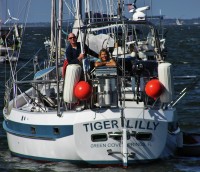
Who: Lilly and Tom Service
Port: Green Cove Springs

